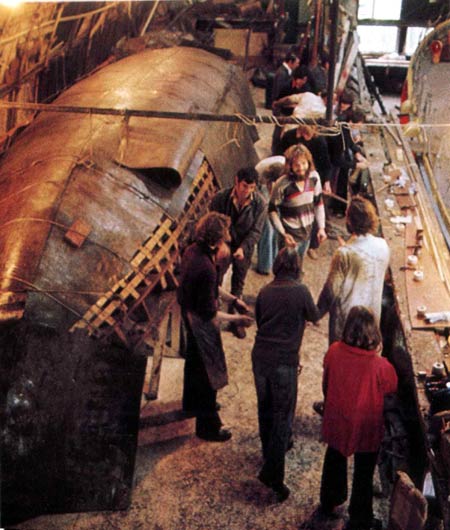The Brendan Voyage
by Tim Severin
The Northern Atlantic: a cold, damp, inhospitable place where fog shrouds the icebergs and through which any craft must pick its way with infinite care; a tempestuous and lethal place.
 It is against this environment that Tim Severin tested a leather curragh - the Brendan. Closely related to the Welsh Coracle, the Irish Curragh is made from a lightweight wooden frame tied with leather thongs waterproofed by a tanned and greased leather skin. In contrast to the saucer-like coracle, the curragh is a more "boat-shaped" craft designed for use on the Atlantic seaboard of Ireland; these skin-on-frame boats also attain a much greater size than the river-running coracle.
It is against this environment that Tim Severin tested a leather curragh - the Brendan. Closely related to the Welsh Coracle, the Irish Curragh is made from a lightweight wooden frame tied with leather thongs waterproofed by a tanned and greased leather skin. In contrast to the saucer-like coracle, the curragh is a more "boat-shaped" craft designed for use on the Atlantic seaboard of Ireland; these skin-on-frame boats also attain a much greater size than the river-running coracle.
A historian by profession, Severin's motivation to test the Brendan was born partly from his wife's professional interests in Spanish mediaeval texts and she brought a mediaevel celtic script entitled "Navigatio" to his attention. The document seemed to describe an incredible voyage by Celtic monks to the New World via the "Stepping Stones" route: from Ireland to the Shetland Isles, then to the Faroes, Iceland, Greenland and finally to the coast of Labrador.
That such a voyage was possible using any eighth-century technology seemed implausible. To complete such a voyage in a small wood-framed and leather-bound craft seemed far beyond belief. Yet by an extraordinary feat of experimental archaeology, Tim Severin set out to show against all expectations not just the plausibility of the theory of eighth century monks globe-trotting in frail cockle-shells, but also the reliability of the Navigatio account.

I found this a delightful book to read in common with Thor Heyerdahl's "The Ra Expeditions" (review), except that where Heyerdahl's book is a riot of raucous literary colour, Severin's book feels a more detailed portrait of the beauty of the Northern Atlantic wastes. I particularly enjoyed his descriptions of the northern island lands, and their hardy occupants. Severin writes well with an easy style, presumably crafted as a historian and although the main thrust of his writing is certainly biased towards both the performance of the Brendan and the realities and dangers of life aboard a primitive sailing craft in the open sea, Severin maintains interest with the inescapable dramas of the voyage such as running the narrow Mykines Sound in half a gale atop a racing tide with seabirds screaming from the adjacent cliffs, at times only minutes from shipwreck. Again, between Greenland and Labrador Brendan was caught in a vagrant ice flow after a gale had shattered the edge of the Greenland ice shelf: Brendan was caught between two enormous ice floes and it was only the inherent resilience of the craft herself and the hardiness of her occupants that averted disaster.
Severin writes an interesting book on many levels. For the sailor this may be enjoyed both as a journey across the North Atlantic and as an adventurous voyage against the odds, but as an investigation of mediaeval seafaring and mankind's ability for survival in extreme conditions the book is equally fascinating. It has certainly inspired me to wish to visit many of the lands visited and any book with that ability comes strongly recommended.
Best wishes.
Alistair Wasey

